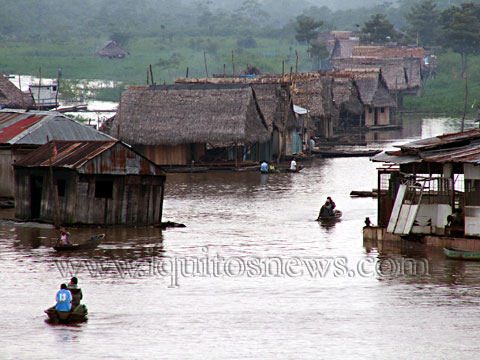consider myself lucky enough to be traveling around South America, and since coming to Iquitos, even luckier for a couple of reasons. Coming from a country such as Finland, I find myself in an environment almost as opposite as possible to where I grew up. Finland is clean, quiet, fresh, and yes, cold! Iquitos is just not so. It's hot, very humid, sexy, chaotic and, of course, in the middle of the biggest rain forest of this planet. That's the first reason I feel so lucky.
Another reason is that during a little road trip of my own country prior to coming to South America, my boyfriend and I bumped into a biologist called Anna, who was just about to leave for Iquitos, and told us all about the place. Encouraged by her stories, we decided to head this way and haven't regretted our choice.
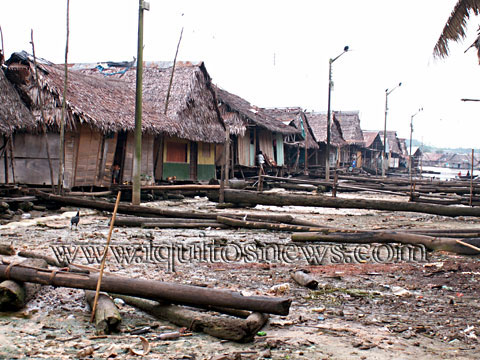 Through Anna and her Peruvian boyfriend Luis, we have been able to get an authentic taste of Iquitos, go where the locals go, and find out information about how people really live in this part of the world. Contrary to most of the people who visit Iquitos, we have not yet surrendered ourselves to the mosquitoes and other scary bugs of the jungle. Instead, we've been bumming around the different areas in and around Iquitos. One of the most interesting things we have done, is a trip to Belen together with our friends. Belen is poor, colorful, chaotic, crazy and a bit wild. Go there if you can yourself, but here's a little taste of our experience. Through Anna and her Peruvian boyfriend Luis, we have been able to get an authentic taste of Iquitos, go where the locals go, and find out information about how people really live in this part of the world. Contrary to most of the people who visit Iquitos, we have not yet surrendered ourselves to the mosquitoes and other scary bugs of the jungle. Instead, we've been bumming around the different areas in and around Iquitos. One of the most interesting things we have done, is a trip to Belen together with our friends. Belen is poor, colorful, chaotic, crazy and a bit wild. Go there if you can yourself, but here's a little taste of our experience.
 Arriving with a
motocarro in the middle of the Plaza of Belen, we were thrown into a scene of manic street vendors selling anything from monkey to
paiche to flashlight batteries. We jumped off the motocarro a bit bewildered, as there was just almost too much to take in at once, so much color, so many strange smells and sights. We were immediately faced by very curious stares from the hundreds of people surrounding us. Some people were even shouting Look, its gringos! - So much for keeping a low profile. Waiting for Luis, we were approached by a few Belen kids, offering us canoes for rent and asking about 5 times the usual price, 2 soles. No, gracias. We obviously were not the first tourists to wander into these parts. But hey, probably I would do the same in their shoes. Afterwards, we were forced off the plaza platform as someone was washing the floor with a fireman's hose and washing everyone else close enough in the process. Arriving with a
motocarro in the middle of the Plaza of Belen, we were thrown into a scene of manic street vendors selling anything from monkey to
paiche to flashlight batteries. We jumped off the motocarro a bit bewildered, as there was just almost too much to take in at once, so much color, so many strange smells and sights. We were immediately faced by very curious stares from the hundreds of people surrounding us. Some people were even shouting Look, its gringos! - So much for keeping a low profile. Waiting for Luis, we were approached by a few Belen kids, offering us canoes for rent and asking about 5 times the usual price, 2 soles. No, gracias. We obviously were not the first tourists to wander into these parts. But hey, probably I would do the same in their shoes. Afterwards, we were forced off the plaza platform as someone was washing the floor with a fireman's hose and washing everyone else close enough in the process.
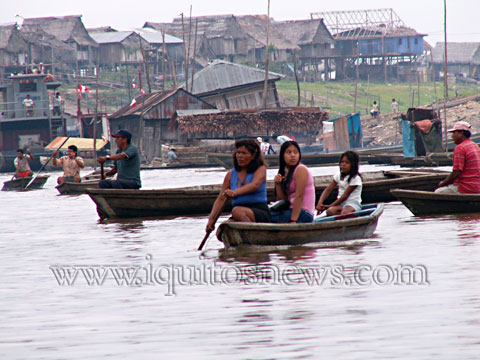 Once Luis arrived, he took us to his parents' place deeper in Belen. More curious stares on the way. We sat down for a snack of dried palm hearts (recommended) and found out that Luis's parents' house routinely floods the water completely fills the ground floor a couple of months of the year. Amazed, I asked what they do with all of their belongings when this happens, and found out that they simply pack it all up and move the whole family to the upper floor of their house for the duration, the dog and all. The worst part is, this ain't no fresh rainwater instead we are talking about sewage, stink, and rubbish from the whole neighborhood filling your living room. Fortunately, for the third year running, the water hasn't risen up to their house, and the parents had been spared the trouble, although nobody knows why. Once Luis arrived, he took us to his parents' place deeper in Belen. More curious stares on the way. We sat down for a snack of dried palm hearts (recommended) and found out that Luis's parents' house routinely floods the water completely fills the ground floor a couple of months of the year. Amazed, I asked what they do with all of their belongings when this happens, and found out that they simply pack it all up and move the whole family to the upper floor of their house for the duration, the dog and all. The worst part is, this ain't no fresh rainwater instead we are talking about sewage, stink, and rubbish from the whole neighborhood filling your living room. Fortunately, for the third year running, the water hasn't risen up to their house, and the parents had been spared the trouble, although nobody knows why.
We decided to rent a canoe and have a cruise around the floating parts of Belen. Not just a few houses, but a massive area of the district is totally flooded for a couple of months of the year. People build their houses either on stilts a few meters off the ground, or actually have floating houses attached to beams of wood on the sides to keep it from floating away. Sometimes people do actually decide to move, but the traditional way of moving house has adapted to upping your sticks and moving your whole house rather than just your belongings, and floating it to a better spot. Sure beats renting expensive vans and breaking your back carrying the sofa down the stairs.
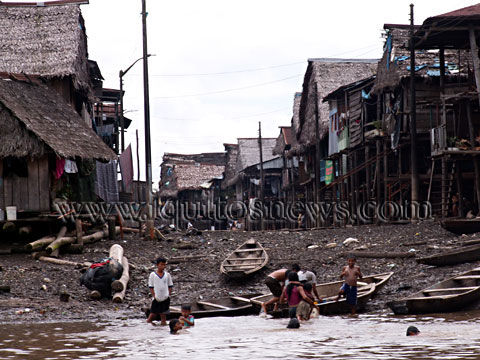 I was immediately struck by how dirty the water looks, and also how surprisingly calm the atmosphere is in this part of Belen. There are no
motocarristas, no pollution only a few people (and sometimes, chicken or dogs) floating quietly past in their canoes. It seems that everyone owns a canoe otherwise it would be impossible to leave your own front porch. I was immediately struck by how dirty the water looks, and also how surprisingly calm the atmosphere is in this part of Belen. There are no
motocarristas, no pollution only a few people (and sometimes, chicken or dogs) floating quietly past in their canoes. It seems that everyone owns a canoe otherwise it would be impossible to leave your own front porch.
We continued further on the 'roads' which of course now are just wide areas of water between the rows of houses, and were constantly greeted by big smiles and waving hands of the people watching us from their windows and porches. Most of the houses are wooden shacks with corrugated iron roofs, and I couldn't help but notice that the toilets are actually outhouses and anything 'deposited' there flushes straight into the water. Yet, many people are forced to wash their clothes or even themselves in the same water that basically is filled with the sewage of the whole neighborhood.
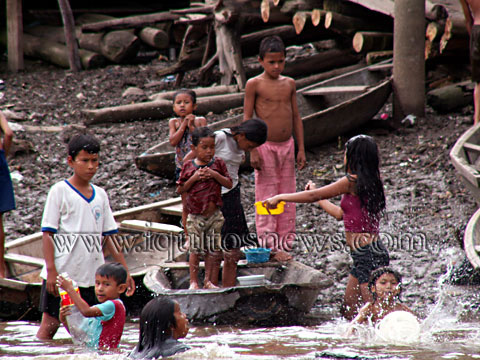 Even so, lots of kids were happily swimming around us in the water. Luis, who grew up in the same area, can't remember when he learnt to swim he just always knew how to. The water is their playground and they sure make the most of it. We received the biggest smiles and show-off jumps and rollies from many of the kids, who really seemed to be enjoying frolicking around in the water. I must admit I was a bit worried of even touching the water myself I suppose like most Europeans I've been brought up in a totally different, freakishly clean and over-the-top hygienic environment.
Because the water levels have not been so high for the last few years, some parts of the usually flooded areas are still dry. Predictably, these fields like most others anywhere in South America, were being used for the biggest Latin passion of all, Football. Kids were showing their skills off to us, and once we stepped off to stretch our legs for a while we were surrounded by a group of girls and boys all staring at us, giggling and trying out their English skills... which mainly seem to be limited to 'Hello' and sometimes even 'Good Morning, Teacher'. We joked around with the kids for a while and headed back to the safety of terra firma at Luis's parents' place. Even so, lots of kids were happily swimming around us in the water. Luis, who grew up in the same area, can't remember when he learnt to swim he just always knew how to. The water is their playground and they sure make the most of it. We received the biggest smiles and show-off jumps and rollies from many of the kids, who really seemed to be enjoying frolicking around in the water. I must admit I was a bit worried of even touching the water myself I suppose like most Europeans I've been brought up in a totally different, freakishly clean and over-the-top hygienic environment.
Because the water levels have not been so high for the last few years, some parts of the usually flooded areas are still dry. Predictably, these fields like most others anywhere in South America, were being used for the biggest Latin passion of all, Football. Kids were showing their skills off to us, and once we stepped off to stretch our legs for a while we were surrounded by a group of girls and boys all staring at us, giggling and trying out their English skills... which mainly seem to be limited to 'Hello' and sometimes even 'Good Morning, Teacher'. We joked around with the kids for a while and headed back to the safety of terra firma at Luis's parents' place.
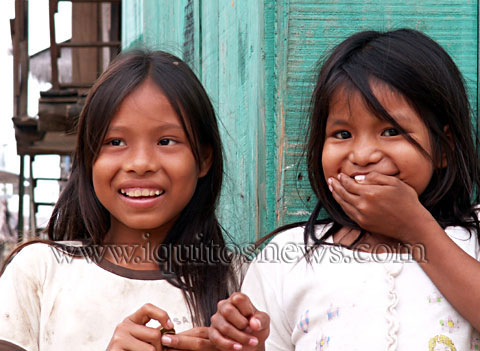 My main impressions of our visit to the floating parts of Belen were the calm, peaceful atmosphere (such a difference from the chaotic dry parts of the district) and frankly, a sense of amazement at how people are able to live in such conditions. I suppose the sad truth is that they don't seem to have much of a choice, but at least the children we saw and talked to seemed happy, swimming around and roaming free. I imagine the hyper-hygienic countries of Western Europe and think how anyone I know would react if their living room freakily was filled with water, rubbish and sewage from their neighbors...let alone let their kids swim in it. Here, the people adapt into the situation and simply get on with living. After all, even with a Peruvian in tow, we had to pay a gringo inflated price for our canoe trip, seven soles in total for about an hour. Locals would apparently only pay a couple of soles, but I consider our experience worth it despite the usual price hike. I would definitely recommend a canoe trip to the floating Belen, as it gives a unique insight into a totally different way of living from our own comfy and cushy lifestyles, even when we think we are 'roughing it'. Make sure you bargain hard and find a canoe with no holes, though. My main impressions of our visit to the floating parts of Belen were the calm, peaceful atmosphere (such a difference from the chaotic dry parts of the district) and frankly, a sense of amazement at how people are able to live in such conditions. I suppose the sad truth is that they don't seem to have much of a choice, but at least the children we saw and talked to seemed happy, swimming around and roaming free. I imagine the hyper-hygienic countries of Western Europe and think how anyone I know would react if their living room freakily was filled with water, rubbish and sewage from their neighbors...let alone let their kids swim in it. Here, the people adapt into the situation and simply get on with living. After all, even with a Peruvian in tow, we had to pay a gringo inflated price for our canoe trip, seven soles in total for about an hour. Locals would apparently only pay a couple of soles, but I consider our experience worth it despite the usual price hike. I would definitely recommend a canoe trip to the floating Belen, as it gives a unique insight into a totally different way of living from our own comfy and cushy lifestyles, even when we think we are 'roughing it'. Make sure you bargain hard and find a canoe with no holes, though.
On from Belen and Iquitos, we have further waterlogged adventures ahead. Our next trip will be slightly more hard-core, assisting our friend with some of her biology fieldwork in a small village up a tributary river of the Amazon. We will be living in the village with the locals, walking in the jungle, bathing in the river ourselves and probably coming back with a few bites and parasites. But, I'm looking forward to understanding life in the Amazon even more. Just gotta take that plunge!
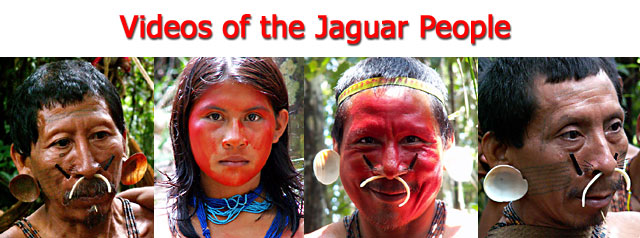
|

